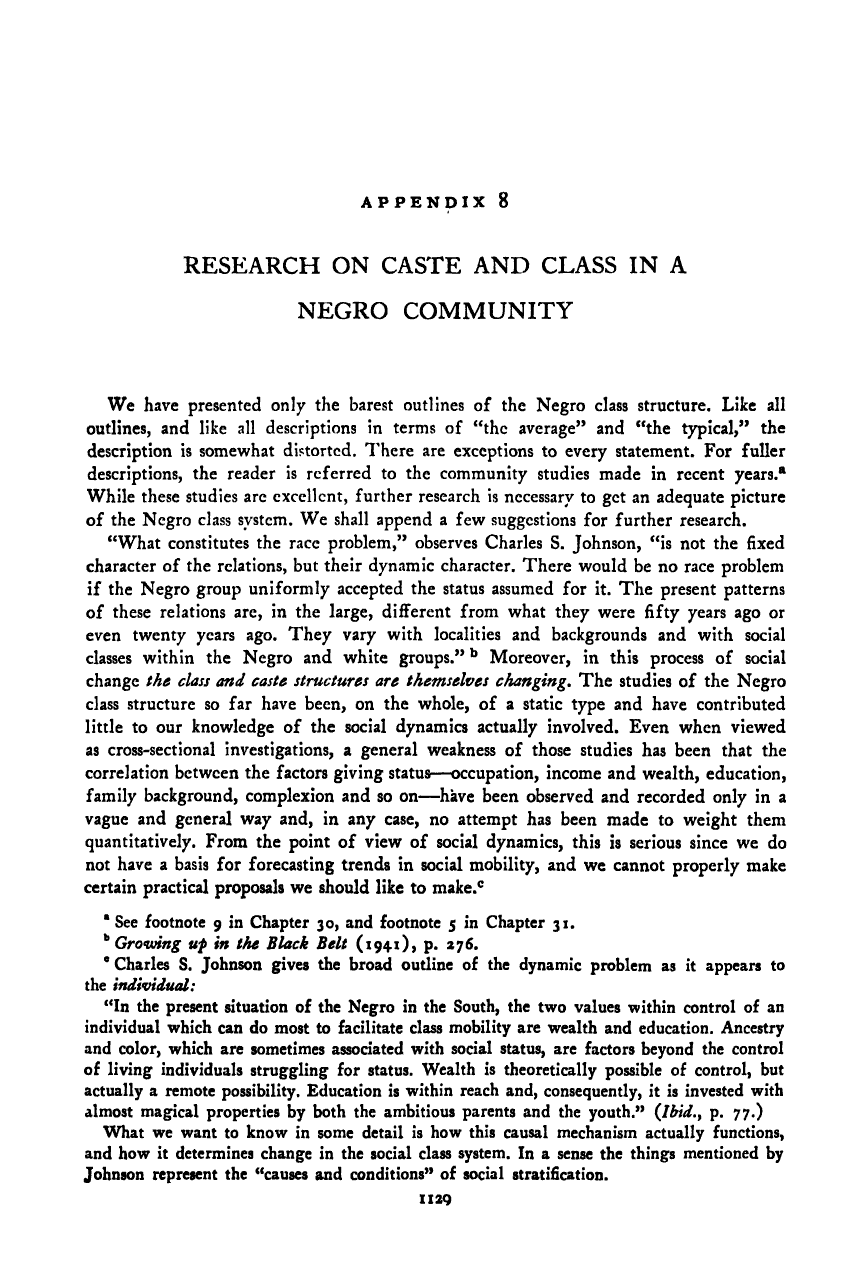Note: Gunnar Myrdal died in 1987, less than 70 years ago. Therefore, this work is protected by copyright, restricting your legal rights to reproduce it. However, you are welcome to view it on screen, as you do now. Read more about copyright.
Full resolution (TIFF) - On this page / på denna sida - Appendices - 8. Research on Caste and Class in a Negro Community

<< prev. page << föreg. sida << >> nästa sida >> next page >>
Below is the raw OCR text
from the above scanned image.
Do you see an error? Proofread the page now!
Här nedan syns maskintolkade texten från faksimilbilden ovan.
Ser du något fel? Korrekturläs sidan nu!
This page has never been proofread. / Denna sida har aldrig korrekturlästs.
APPENDIX 8
RESEARCH ON CASTE AND CLASS IN A
NEGRO COMMUNITY
We have presented only the barest outlines of the Negro class structure. Like all
outlines, and like all descriptions in terms of “the average” and “the typical,” the
description is somewhat distorted. There are exceptions to every statement. For fuller
descriptions, the reader is referred to the community studies made in recent years.®
While these studies arc excellent, further research is necessary to get an adequate picture
of the Negro class system. We shall append a few suggestions for further research.
“What constitutes the race problem,” observes Charles S. Johnson, “is not the fixed
character of the relations, but their dynamic character. There would be no race problem
if the Negro group uniformly accepted the status assumed for it. The present patterns
of these relations are, in the large, different from what they were fifty years ago or
even twenty years ago. They vary with localities and backgrounds and with social
classes within the Negro and white groups.” ^ Moreover, in this process of social
change class and caste structures are themselves changing. The studies of the Negro
class structure so far have been, on the whole, of a static type and have contributed
little to our knowledge of the social dynamics actually involved. Even when viewed
as cross-sectional investigations, a general weakness of those studies has been that the
correlation between the factors giving status—occupation, income and wealth, education,
family background, complexion and so on—^have been observed and recorded only in a
vague and general way and, in any case, no attempt has been made to weight them
quantitatively. From the point of view of social dynamics, this is serious since we do
not have a basis for forecasting trends in social mobility, and we cannot properly make
certain practical proposals we should like to make.^
• See footnote 9 in Chapter 30, and footnote 5 in Chapter 31.
**
Grovnng uf in the Black Belt (1941), p. 276.
* Charles S. Johnson gives the broad outline of the dynamic problem as it appears to
the individual:
“In the present situation of the Negro in the South, the two values within control of an
individual which can do most to facilitate class mobility are wealth and education. Ancestry
and color, which are sometimes associated with social status, are factors beyond the control
of living individuals struggling for status. Wealth is theoretically possible of control, but
actually a remote possibility. Education is within reach and, consequently, it is invested with
almost magical properties by both the ambitious parents and the youth.” (Ibid,, p. 77.)
What we want to know in some detail is how this causal mechanism actually functions,
and how it determines change in the social class system. In a sense the things mentioned by
Johnson represent the “causes and conditions” of social stratification.
1129
<< prev. page << föreg. sida << >> nästa sida >> next page >>